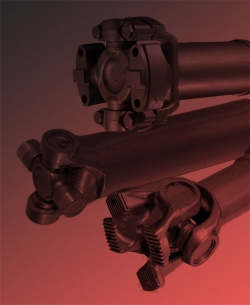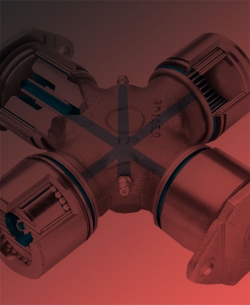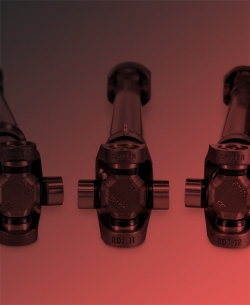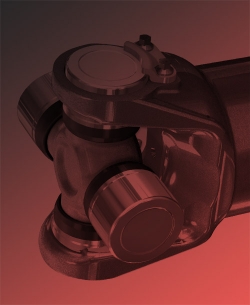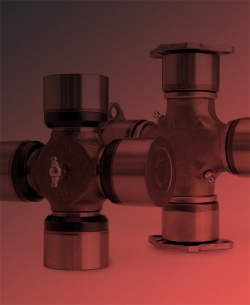INTRODUCTION
At Dana, we understand that universal joint operating angles are crucial in preventing the torsional and inertial effects that can damage many of the driveline components in a vehicle.
U-joint operating angles are typically created during the design of a new vehicle, which is why vehicles usually do not leave the factory with vibration problems caused by improper u-joint operating angles.
Over time, though, parts and suspensions wear. Air bags somehow get out of adjustment or fail, all of which can cause vehicle heights to change, which in turn can cause operating angles to change. In addition, businesses sometimes modify a vehicle’s wheelbase by shortening or lengthening it from the OEM’s original specification, inadvertently changing operating angles.
In the past, you would have had to go to your garage and add a few shims between the frame and axle. Then you would have to drive the vehicle to see if it vibrated. If it did, you would have to repeat the process over and over until you got the best results.
This Torsional Analysis Calculator enables you check a vehicle’s driveline installation for torsional and inertial problems, right from your computer.
All you have to do is enter driveline installation data into the fields and the calculator will perform an instant torsional and inertial analysis. Then you can revise the data and, if you understand u-joint operating angles, correct problems right from your desk.
The first step is to gather the initial data
- You will need to measure all angles with an accurate protractor—preferably a digital protractor.
- You will need a good understanding of slopes as they relate to drivelines.
- You will also need to be able to accurately measure lengths.
Definition of Slopes
- Down Slope: When the rear of a component is lower than the front of a component.
- Up Slope: When the rear of a component is higher than the front of a component.
Example: Most axles have an end yoke that points up, but since the rear of the axle is lower than the front of the axle, it is a down slope for the purposes of this program.
You will have to determine all of the following:
- Maximum drive shaft RPM
- Determined by dividing driver RPM by the lowest transmission ratio.
- The angle and slope of the driving member
- Usually a vehicle's transmission
- The true center line of the application
- The angle and slope of all driveshafts in the application
- The length, in inches, from the center of the U-joint to the center of the U-joint on all driveshafts in the application
- The angle and slope of the driven member
- Usually a vehicle's axle
- The offset, if applicable, of any components when looking down from the top.
Measure all angles and determine all slopes from the driver's side of the vehicle.
A driveline setup in a truck usually consists of a transmission attached to a driveshaft, which is, in turn, attached to an axle. All three of these components usually have a down slope. Ideally, the angles and slopes between these components are not large enough to cause a torsional or inertial problem.
This calculator takes the data you have measured from your vehicle and determines if your torsional and inertial levels could cause a problem. It provides an alert, in red letters, if something is wrong.
If you get a red-letter alert, you can quickly go back into the calculator and make modifications to the setup that can remedy the problem. Typically, the corrective procedure involves changing the angle of the axle with a shim. This will, in turn, change the angle of the driveshaft, because the driveshaft is connected to the axle.
You can then re-enter your new data into the calculator. If further modifications are required, you will receive another alert and you can readjust the data and reanalyze the results, until you get the results you want. Your goal is to get torsional and inertial results that are as close to zero as possible.
How to Use the Torsional Analysis Calculator
This tutorial will walk you through the use of the program for a typical vehicle with two driveshafts. Use the figures below as though they are the data you measured from your vehicle. We are going to pretend we have a vehicle with a new vibration problem and that someone had removed the shafts from this vehicle and re-installed the first shaft, inadvertently leaving out the center bearing shims.
We will check the torsionals on the vehicle the way it is sitting, then go back and put the shims back in and check it again. It should be OK.
- Enter the initial vehicle data and click "Results".
- If you notice a mistake in your data entries, you can return to that field, and re-enter your data.
- You can return to the Top/Side View buttons at any time to revise your entries, if your results are too high.
- When you go back, you can only change certain data, based on the type of vehicle data you have entered:
- On a one-shaft vehicle, you can only change the angle of the driven member. You cannot change the angle of the driving member because it is “fixed” in the vehicle. You also cannot change the driveshaft because it is attached to the driven member and “moves” with any changes in the angle of the driven member.
- On a multi-shaft vehicle, you cannot change the angle of the driving member or the rearmost driveshaft because it is attached to the driven member and “moves” with any changes in the angle of the driven member. However, you can change the angles of any driveshafts in front of the rearmost shaft. You usually do that by adding or removing shims under the center bearings.
1. Enter the data below
| Number of shafts | 2 |
| Truck Type | Light Duty |
| Driveshaft RPM | 2500 |
| Shaft 1 Angle & Slope | 0˚ degress, Down |
| Shaft 1 Length | 40" inches |
| Shaft 2 Angle & Slope | 6˚ degrees, Down |
| Shaft 2 Length | 50" inches |
| Driver Angle & Slope | 4˚ degrees, Down |
| Driven Angle & Slope | 5˚ degrees, Down |
Note: Slope is immaterial when you enter a zero degree angle.
2. Click "Results"
Note that torsionals are high and the inertia effects at the driven end of the shaft are excessive. That should tell you that your angles are not canceled and your operating angle at the driven end of your shaft is probably too large.
- Click "Side View Angles & Lengths"
- Change the angle of the first shaft from zero to 3.5˚ degrees / Select "Down"
- Note that the Shaft 2 Angle changed, because it is attached to Shaft 1.
- Click "Results"
Torsionals are now great and the inertia effects at the driven member have been reduced to acceptable limits.
Points to Remember
- The smaller the operating angle, the smaller the inertia vibrations.
- The closer the operating angles at each end of a driveshaft are to being equal, the smaller the torsional vibrations.
- That’s why our torsionals are so good. We have small angles on both ends.
Please download our step-by-step tutorial.
By clicking the continue button below you acknowledge that you have read and understand the statements provided above.




